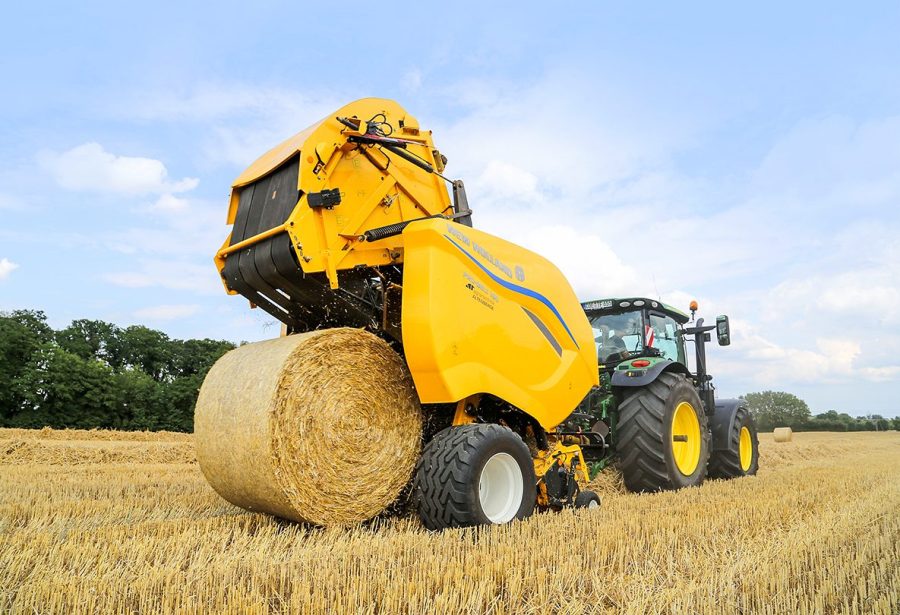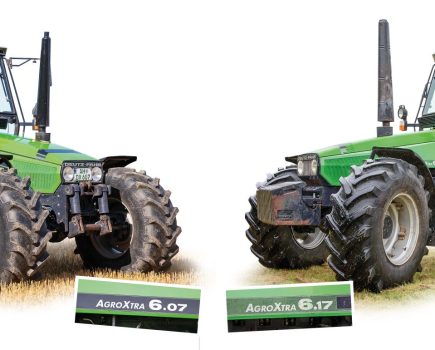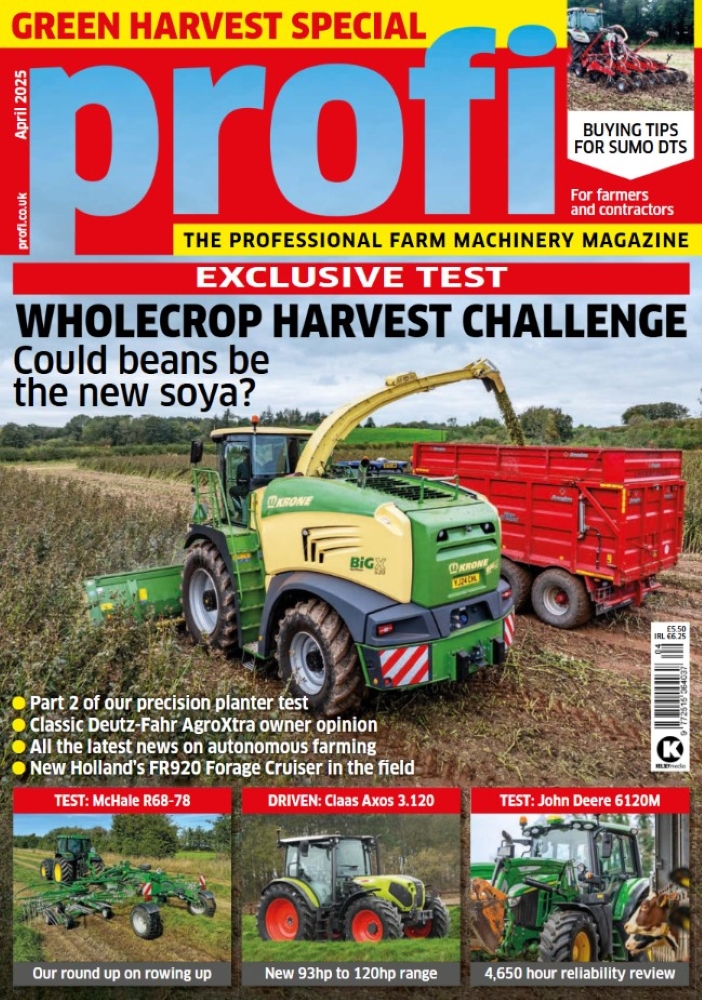New Holland’s Pro-Belt variable-chamber baler with the 25-knife CropCutter chopping system came into its own in last season’s difficult conditions. Read on to see why we liked the PB165.
KEEPING IT BRIEF
- Onboard hydraulic system.
- Operation and menu navigation are exemplary and intuitive.
- The reinforced parts and chains make a solid impression. Overall verdict is that it is well thought out.
- Produced at the Plock factory in Poland.
Although it has its long serving Roll-Belt variable chamber baler range, for those users demanding something even more hardcore, New Holland has created the Pro-Belt. This line consists of two models: the small PB165 that produces bales measuring 0.90-1.65m in diameter and the PB190 for up to 1.90m bales. Both come in two flavours: SuperFeed with no chopping or the CropCutter with 13 or 25 knives.
Our test machine was the 25-knife, Pro-Belt 165 which we used for packing away straw, hay and silage in a tricky season.
CNH engineers have designed the Pro-Belt to be mechanically simpler with fewer moving parts than the Roll-Belt balers; the additional benefit is that it makes maintenance easier. To continue the theme, the chamber rollers and their bearings are noticeably bigger and heavier, too. The same applies to the guide rollers for the four belts, which are beefier and larger in diameter than those in the Roll-Belt. They are also vulcanized on the outside and have a double drive. Lastly, the frame gains some extra metal meat.
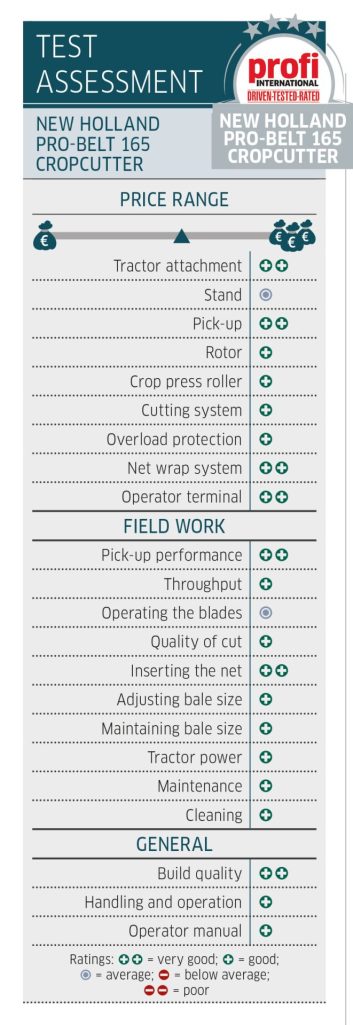
Drawbar position is key for smooth crop flow
The drawbar height can be infinitely adjusted on the spindles to suit tractors on different size tyres or if you want to change from a low hitch to the less popular top mount type — the world is your oyster here. Standard fit is a hitch ring, but you can also plump for a K80 spoon. All of this paves the way for tidy and efficient crop flow.
We liked the slim drawbar design, which gives tight turns with the wide-angle Walterscheid pto and, above all, a good view of the pick-up. The hose rack, too, is adjustable and does a reliable job of keeping the four hydraulic hoses for the two double-acting spools out of harm’s way. The pick-up, drop floor and knives are looked after by one spool, with the function pre-selected on the control box. Spool two is dedicated to the back door.
All the hoses are clearly marked with grippy aluminium fittings. Then there are the cables for ISObus and lights plus the brake lines. The parking stand is located on the right-hand side of the frame where it sits high enough off the ground that it doesn’t interfere with the crop flow, not even in big rows of straw.
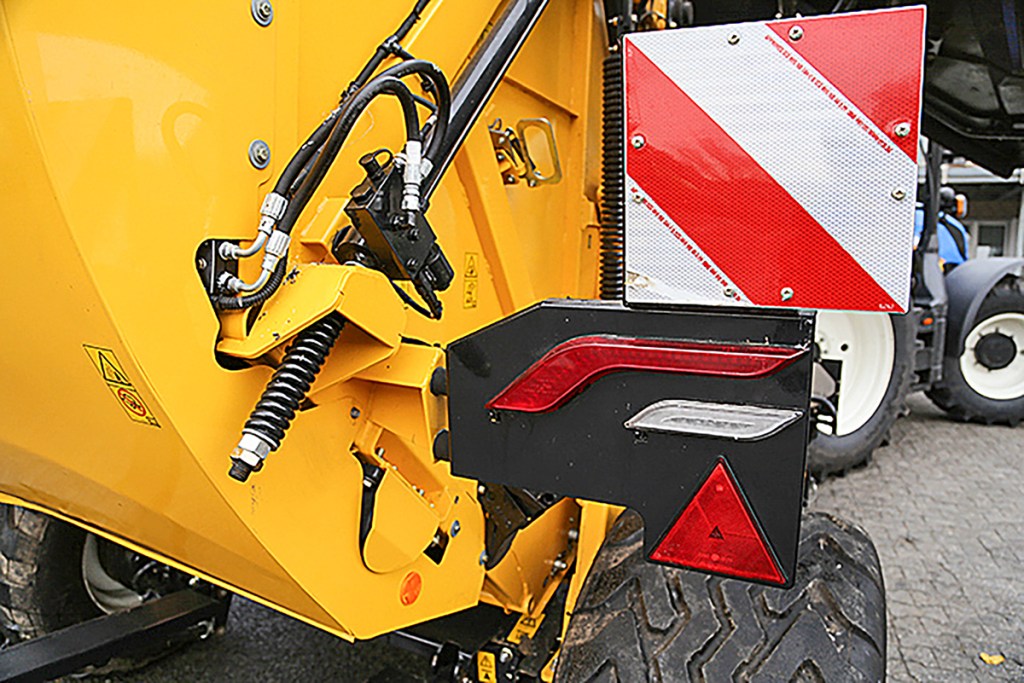
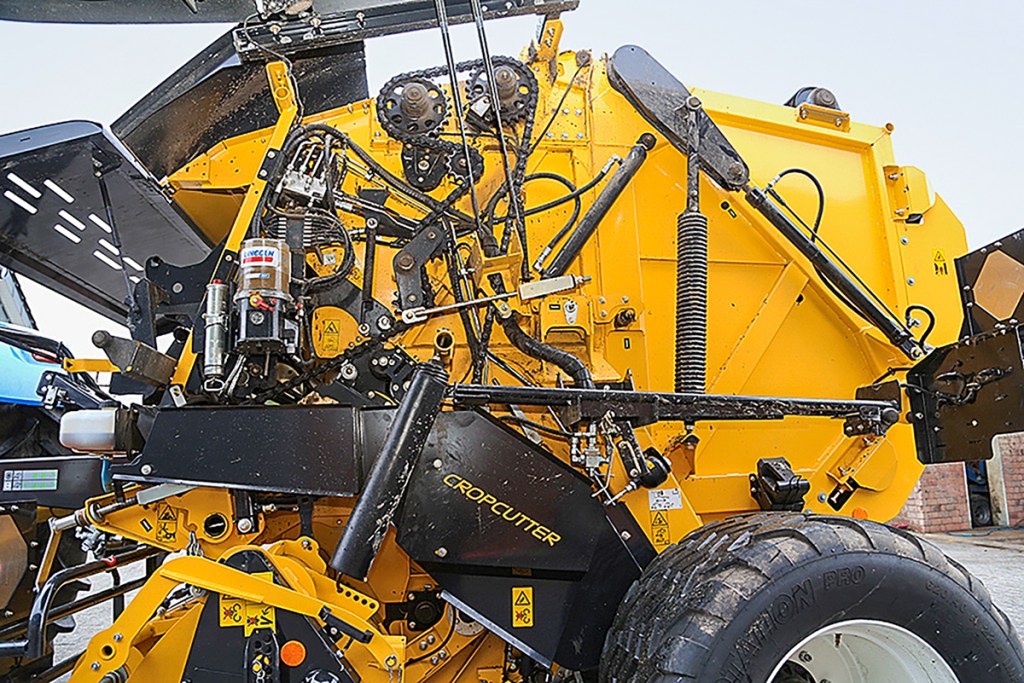
Solid drive
The baler is powered by the 1,000rpm shaft. The transfer box also comes from Walterscheid and is protected up to 4,000Nm with a max of 200hp permissible. Drive power is then split equally to both sides of the baler. The belts and lower chamber rollers are all driven from the left. On the right is the driveline for the starter roller, rotor and pick-up.
There are just four large drive chains on the Pro-Belt, all of which have tensioners.
The four belts wrap around their drive rollers by up to 300°. We can vouch for the Pro-Belt drive system working reliably, even in wet conditions.
The belt cleaning rollers also worked well; we only had to step in and do a spot of cleaning when the straw was frayed and broken, to prevent it from wrapping.
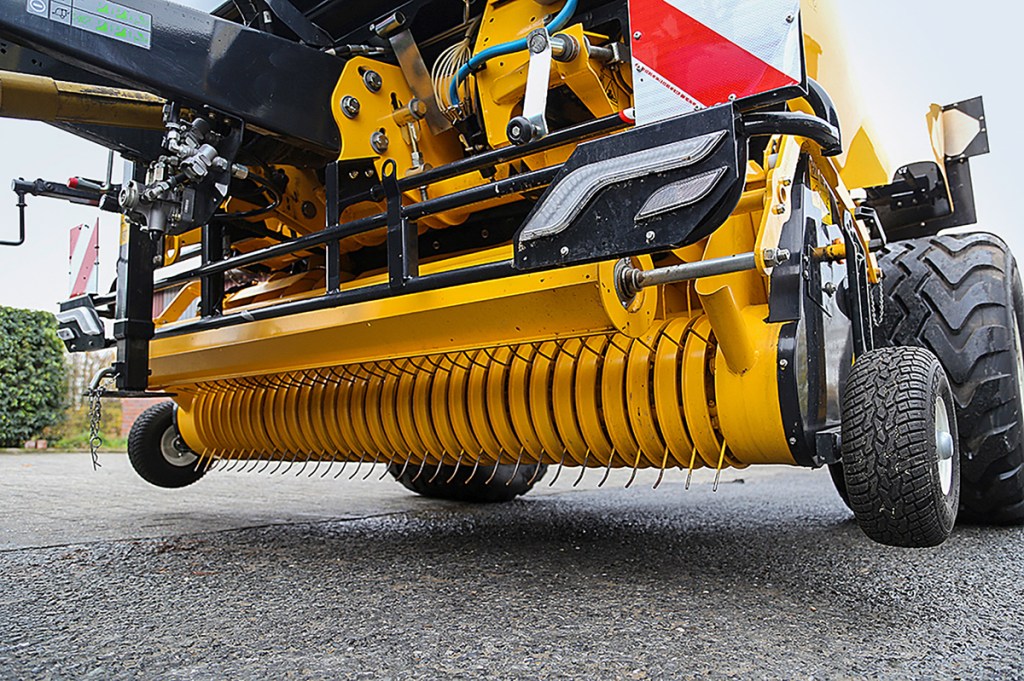
Hungry mouth
The pick-up measures 2.07m from tine to tine — very good for wide rows or when following a curved swath. Curved deflector plates on the outer edges prevent material jamming — we really liked these.
The cam track has five rows of tines, 160 in total, which have the familiar rubber mounts. These are well suited to heavy crops, but in our experience also do a great job in brittle straw and late grass. The reliable performance is also attributed to the central mounting of the pick-up bearing and the split tine carriers.
Pick-up contouring comes from the two rigid gauge wheels (standard and fitted to our baler), which can remain in their work position even when travelling on road. They do serve their purpose and have a finely spaced hole pattern that allows for precise adaptation to terrain and conditions. New Holland does offer steerable gauge wheels as an option, priced at £652
The crop roller crop press pre-compacts the swath. It can be adjusted or removed. As this roller weighs almost 70kg, this isn’t exactly a fun job, especially if you don’t have a helper to assist.
Behind the pick-up, there are two feed augers, one on either side. Provided the swath is wide enough, they supply the rotor across its full width. Having proven their worth in earlier tests, they didn’t disappoint this time either. Those who often deal with voluminous swaths can opt for an extra crop roller with paddles that sits above the pick-up and ahead of the rotor £584
Two other things stand out on the pick-up: the good guard rail that is made of round tubes; and the mechanical locking mechanism via a crank that secures the pick-up from being lowered accidentally.
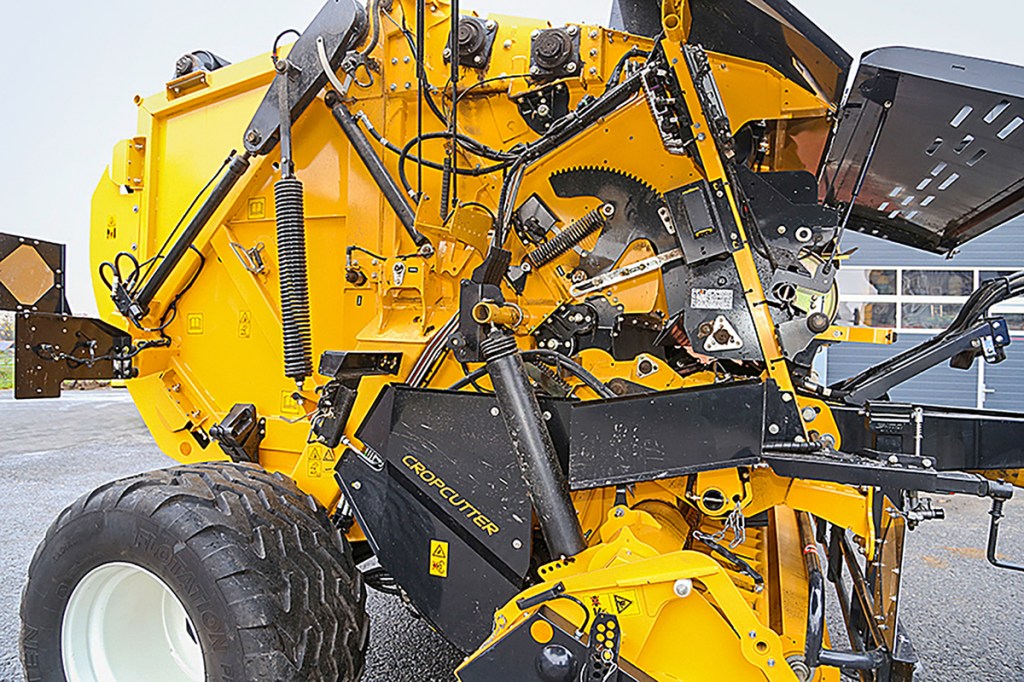
Heavy rotor
All rotors (standard and optional) measure 520mm in diameter; our CropCutter rotor had 25 blades for a nominal chop length of up to 42mm. The 6mm rotor tines are said to be made of abrasion-resistant material. They are arranged in a chevron formation for a more consistent crop flow. The hefty 167kg rotor is reckoned to provide plenty of inertia.
The spring-loaded floor under the rotor can open up to 10mm to avoid major blockages, so smaller lumps and tough straw can pass through without bunging up the machine. The in-cab display issues a warning when the floor starts to flex and open, just in case the user is pushing a bit too hard. If you do bung up the intake, you can drop the floor hydraulically from the cab so the lump can pass through. This always worked fine during our test.
The knives are arranged in two groups and are hydraulically pre-tensioned. The blades can’t retract individually in the event of an overload; it’s always the bank that moves out of the crop flow. The number of knives (0, 12, 13, 25) is preselected on the terminal, and the blades move in and out hydraulically.
When not needed, the knives swing out of the crop channel. Just make sure to operate them from time to time to stop them from sticking or fit the blank knives which are provided.
Three rollers, four belts
The chamber of the Pro-Belt 165 consists of three compression rollers and four endless, 273mm wide belts that are vulcanized along their sides. In our test, we found the belts stayed inline and didn’t wander on the rollers even in difficult conditions. We also liked how the bale started to form all the time.
The bale density is set on the terminal and adjusted hydraulically via a tensioning arm. There are two density zones: first, the core, which can be defined in the 0.90-1.35m range with an individual density; the second zone is the outer layer from the soft core to the edge, where you can also set a separate density within a specific range.
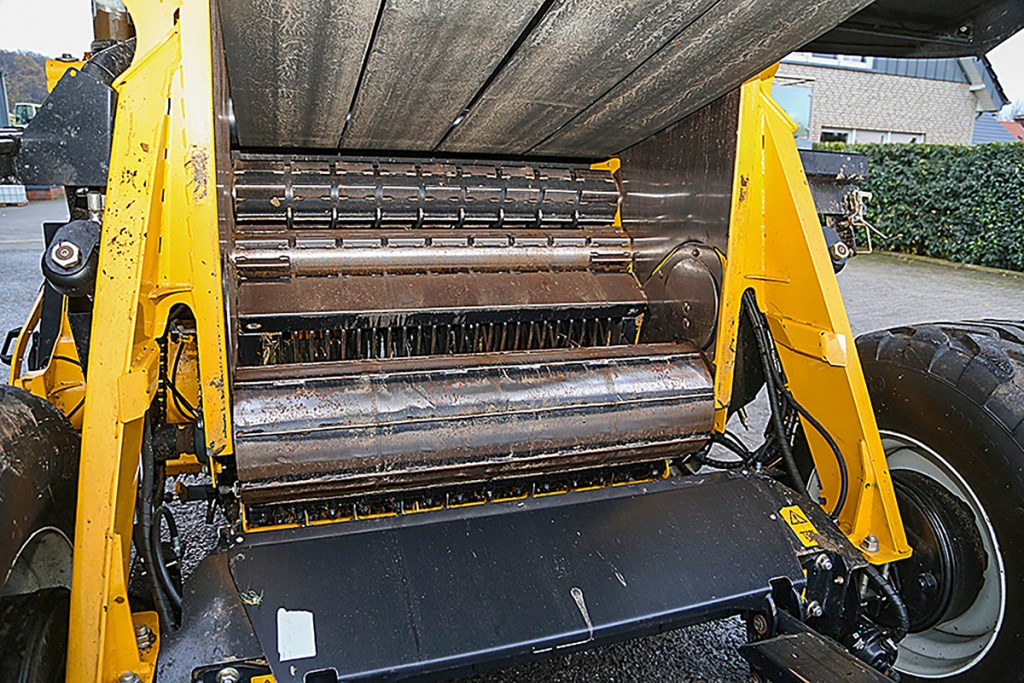
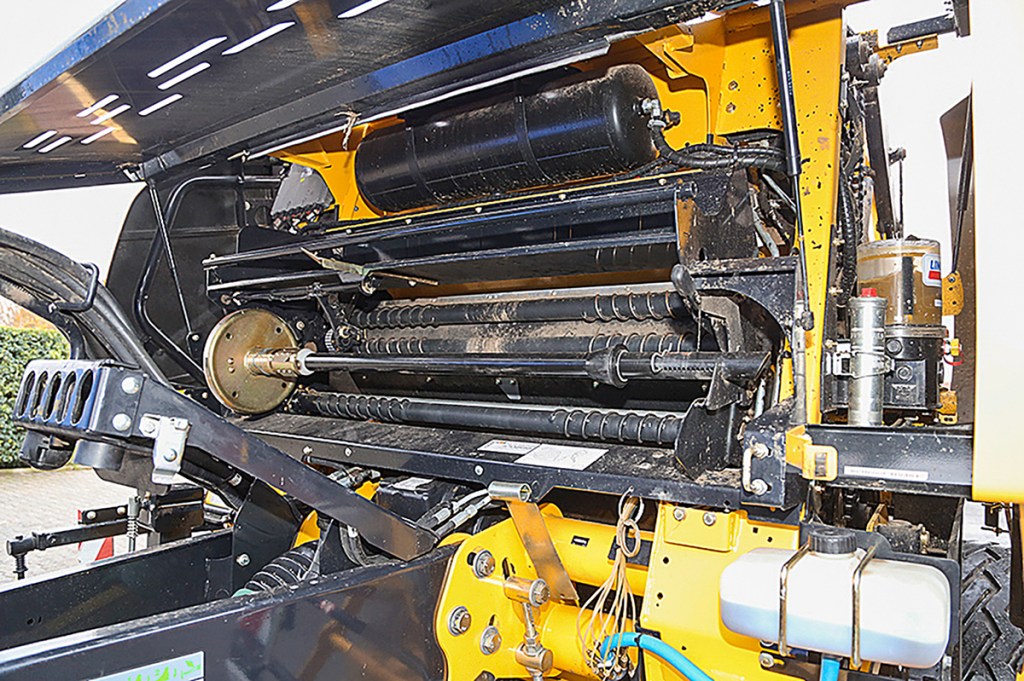
Proven net wrapping system
The NH net system is an established system. Rolls of net (up to a max length of 4,500m) are placed on a cradle and swung up over the drawbar to the net area — excellent.
Once the roll is in place, pull some of the net off and thread the end around the guide roller and the stretch roller before feeding it into the chamber via the well-known ‘duckbill’. A slider is stored near the handle and is there to help with threading the net so that enough is put in to ensure wrapping starts smoothly, regardless of the material in the chamber. This works well, so that false starts are almost impossible. The net is 1.23m wide and covers the edge of the bale so it keeps its shape.
Two spare rolls can be stored on the machine — in the tray above the net-wrap compartment and one on the left of the machine above the wheel. The bracket there consists of two tubes, which has an advantage and a disadvantage: chaff can’t collect, which is good, but then the wheel flings up muck and soil, contaminating the rolls’ packaging.
Standard ISObus
All Pro-Belt machines come with ISObus and can be controlled using the compatible tractor screen or a separate terminal — New Holland supplies its IntelliView IV screen with the baler, which is worth £1,989.
We liked the user interface and the menus. The touch screen works well: all functions are logically grouped together and can be quickly adapted to the current conditions. You can store up to four separate bale profiles (as in density zones, diameter, number of net layers) and change the profile when changing crops. No need to enter each setting manually.
There is also a separate button for switching the double-acting spool to the pick-up, rotor floor and the knife banks — very good. Bale diameter can be adjusted in 5cm increments and, according to our test measurements, are precisely maintained. Baling progress is shown in the middle of the screen. The two columns above the baler icon inform the operator if they need to steer to the left or right to make an even bale.
We also liked the new customer management: jobs can be created and logged with just a few clicks. This can be really helpful if you’re frequently changing fields and working for different customers. And you don’t need any additional software to use it.
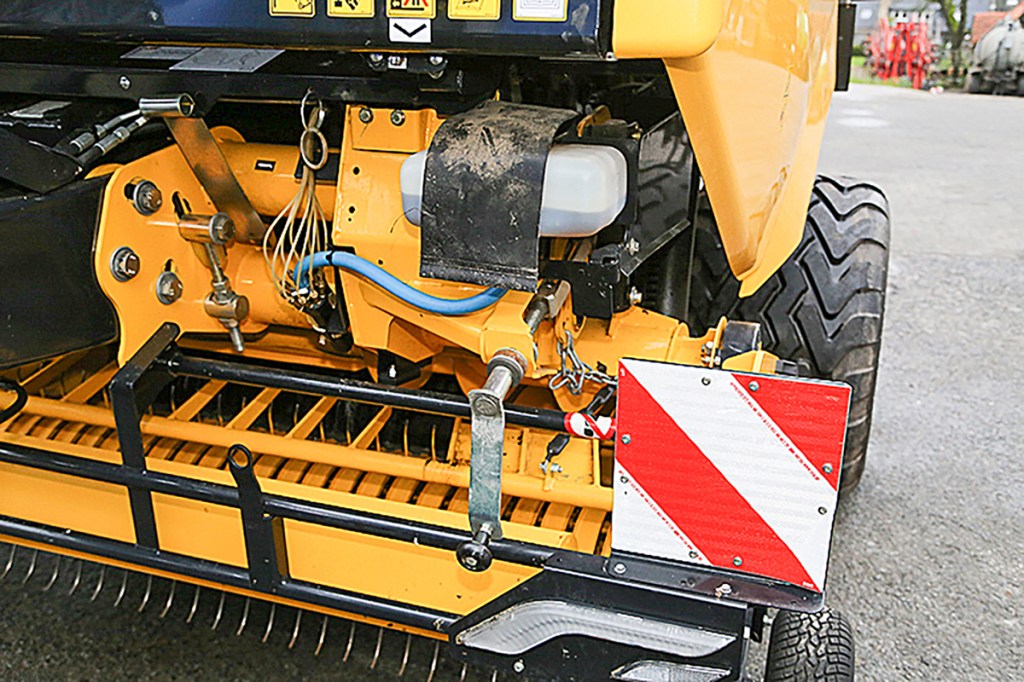
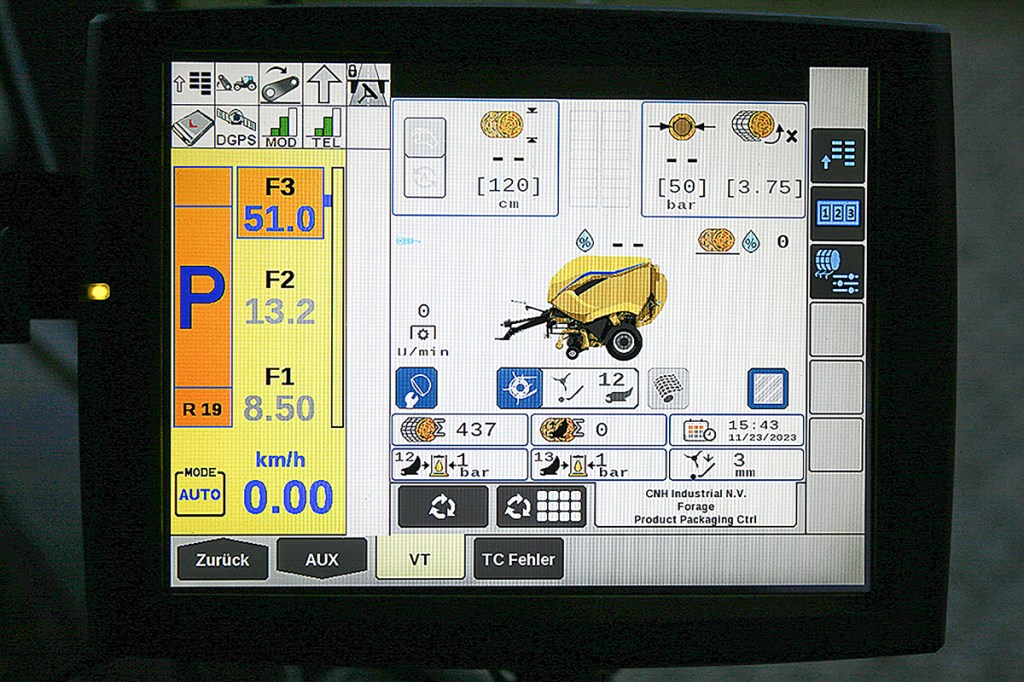
Use and maintenance
Last season the NH Pro-Belt 165 baler was given the opportunity to shine. Due to the wet weather, we decided not to do our usual throughput measurements or measure the cycle times, because the results wouldn’t be comparable with balers we’ve tested in other years in usually dry conditions that have been tedded and rakes several times. However, we did weigh some of the bales. At 80% bale pressure (which is what we always use for our tests), we produced 1.60m bales , which weighed 330kg on average.
The baler swallowed up and processed any type of crop we put in front of it, especially the friable and brittle straw, without any hiccups. And with a little help from the user, the Pro-Belt still turned poor swaths into good bales. There is an in-chamber moisture meter option £984, but this wasn’t on our machine; however it’s something we would certainly recommend adding.
The tailgate opens and closes quickly for respectable throughputs. The appropriate screen prompts are timed well so no second is wasted; the signal for opening the door is issued as soon as the net is cut. Then the bale rolls safely out of the chamber. We never had a bale stuck in the chamber. The ramp ensures that the bale rolls away from the machine (at least on level ground), so the door can be safely closed without damaging the bale.
We also liked the auto-lube system, although we did reduce the oiling rate; this receives its signal every time the door is opened and was set a bit too generous at the factory. The auto-greaser is sourced from Lincoln and looks after most of the grease points.
The Pro-Belt is relatively easy to keep clean and blow down. Indeed, even right from the start, very little chaff and dirt collected on the machine, which is very good, with the bonus that it also reduces the potential risk of fire.
Summary
With the Pro-Belt series, New Holland has come up with higher performance machines to sit above the Roll-Belt range, yet they rely on fewer moving parts and hugely beefed up components. This was shown in the test, with the Pro-Belt 165 making a really solid impression and underlined by the unladen weight of almost 4.9 tonnes.
The drawbar has plenty of adjustment for optimum crop flow, the pick-up and rotor are powerful, and the 25-blade chopping unit slices down to 42mm. Cycle speeds are fast, and bales are ejected equally quickly. The Pro-Belt is a machine that’s in the top league. List price for the test machine is up there, too, at £82,398.
Christian Brüse
For more up-to-date farming news click here and subscribe now to profi and save.

